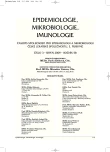Apitherapy – the Role of Honey in the Chronic Wound Healing Process
Authors:
J. Majtán 1,2
Authors place of work:
Ústav Zoológie, Slovenská Akadémia Vied, Bratislava
1; Oddelenie mikrobiológie, Slovenská Zdravotnícka Univerzita, Bratislava
2
Published in the journal:
Epidemiol. Mikrobiol. Imunol. 58, 2009, č. 3, s. 137-140
Summary
With increasing frequency, modern medicine directs attention to natural products and biological therapy methods and their use in clinical practice. Bee honey as well as other bee products (propolis, royal jelly and venom) have already found use in medicine not only as immune system stimulants but also as chronic wound healing promoters. The major arguments for implementing apitherapy are the low cost in comparison with conventional therapies and the fact that honey has proved effective against resistant hospital pathogens. Besides antimicrobial characteristics associated with no antimicrobial resistance risk, honey has anti-inflammatory effects. Controlled clinical trials have shown honey to be effective in chronic wound healing and gave rise to medihoney. Nevertheless, further study is needed to confirm the efficacy and safety of honey in clinical practice.
Key words:
apitherapy, honey, wound healing, antimicrobial effect.
Zdroje
1. Abuharfeil, N., Al-Oran, R., Abo-Shehada, M. The effect of bee honey on proliferative activity of human B- and T-lymphocytes and the activity of phagocytes. Food Agri Immunol, 1999, 11, 169-177.
2. Allen, K.L., Molan, P.C., Reid, G.M. A survey of the antibacterial activity of some New Zealand honeys. J Pharm Pharmacol, 1991, 43, 817-822.
3. Bauer, L., Kohlich, A., Hirschwehr, R., Siemann, U. et al. Food allergy to honey: pollen or bee products? Characterization of allergenic proteins in honey by means of immunoblotting. J Allergy Clin Immunol, 1996, 97, 65-73.
4. Cooper, R.A., Molan, P.C., Harding, K.G. The sensitivity to honey of Gram-positive cocci of clinical significance isolated from wounds. J Appl Microbiol, 2002, 93, 857-863.
5. Fukuda, M., Kobayashi, K., Hirono, Y., Miyagawa, M. et al. Jungle Honey Enhances Immune Function and Antitumor Activity. Evid Based Complement Alternat Med, 2009, doi: 10.1093/ecam/nen086.
6. Lin, S.M., Molan, P.C., Cursons, R.T. The in vitro susceptibility of Campylobacter spp. To the antibacterial effect of manuka honey. Eur J Clin Microbiol Infect Dis, 2009, doi: 10.1007/s10096-008-0630-3.
7. Lusby, P.E., Coombes, A.L., Wilkinson, J.M. Bactericidal, activity of different honeys against pathogenic bacteria. Arch Med Res, 2005, 36, 464-467.
8. Lusby, P.E., Coombes, A., Wilkinson, J.M. Honey: a potent agent for wound healing? J WOCN, 2002, 29, 295-300.
9. Mah, T.F., OęToole, G.A. Mechanisms of biofilm resistance to antimicrobial agents. Trends Microbiol, 2001, 9, 34-39.
10. Majtán, J., Kováčová, E., Bíliková, K., Šimúth, J. The immunostimulatory effect of the recombinant apalbumin 1-major honeybee royal jelly protein-on TNFalpha release. Int Immunopharmacol, 2006, 6, 269-278.
11. Majtán, J., Majtánová, Ľ., Xu, M., Majtán, V. In vitro effect of subinhibitory concentrations of antibiotics on biofilm formation by clinical strains of Salmonella enterica serovar Typhimurium isolated in Slovakia. J Appl Microbiol, 2008, 104, 1294-1301.
12. Mavric, E., Wittmann, S., Barth, G., Henle, T. Identification and quantification of methylglyoxal as the dominant antibacterial constituent of Manuka (Leptosperum scoparium) honeys from New Zealand. Mol Nutr Food Res, 2008, 52, 483-489.
13. Molan, P.C. The evidence supporting the use of honey as a wound dressing. Int J Low Extrem Wounds, 2006, 5, 40-54.
14. Namias, N. Honey in the management of infections. Surg Infect, 2003, 4, 219-226.
15. Ruhston, I. Understanding the role of proteases and pH in wound healing. Nurs Stand, 2007, 21, 68-72.
16. Russell, K.M., Molan, P.C., Wilkins, A.L., Holland, P.T. Identification of some antibacterial constituents of New Zealand manuka honey. J Agric Food Chem, 1990, 38, 10-13.
17. Tonks, A.J., Cooper, R.A., Jones, K.P., Blair, et al. Honey stimulates inflammatory cytokine production from monocytes. Cytokine, 2003, 21, 242-247.
18. Tonks, A.J., Dudley, E., Porter, N.G., Parton, J. et al. A 5.8-kDa component of manuka honey stimulates immune cells via TLR4. J Leukoc Biol, 2007, 82, 1147-1155.
19. Simon, A., Traynor, K., Santos, K., Blaser, G. et al. Medical honey for wound care – still the ęlatest resortę? Evid Based Complement Alternat Med, 2009, doi: 10.1093/ecam/nem175.
20. Šimúth, J., Bíliková, K., Kováčová, E., Kuzmová, Z., Schroder, W. Immunochemical approach to detection of adulteration in honey: physiologically active royal jelly protein stimulating TNF- is a regular component of honey. J Agric Food Chem, 2004, 52, 2154-2158.
Štítky
Hygiena a epidemiológia Infekčné lekárstvo MikrobiológiaČlánok vyšiel v časopise
Epidemiologie, mikrobiologie, imunologie

2009 Číslo 3
- Parazitičtí červi v terapii Crohnovy choroby a dalších zánětlivých autoimunitních onemocnění
- Očkování proti virové hemoragické horečce Ebola experimentální vakcínou rVSVDG-ZEBOV-GP
- Koronavirus hýbe světem: Víte jak se chránit a jak postupovat v případě podezření?
Najčítanejšie v tomto čísle
- Použitie metódy PCR v diagnostike enterovírusových infekcií
- Apiterapia – úloha medu v procese hojenie chronických rán
- Epidemický výskyt vodou přenosných chorob v České republice za období 1995 až 2005
- Výsledky sérologie hantavirů z klinických vzorků vyšetřených v období 1998-2008 na oddělení virologie Zdravotního ústavu v Ostravě
